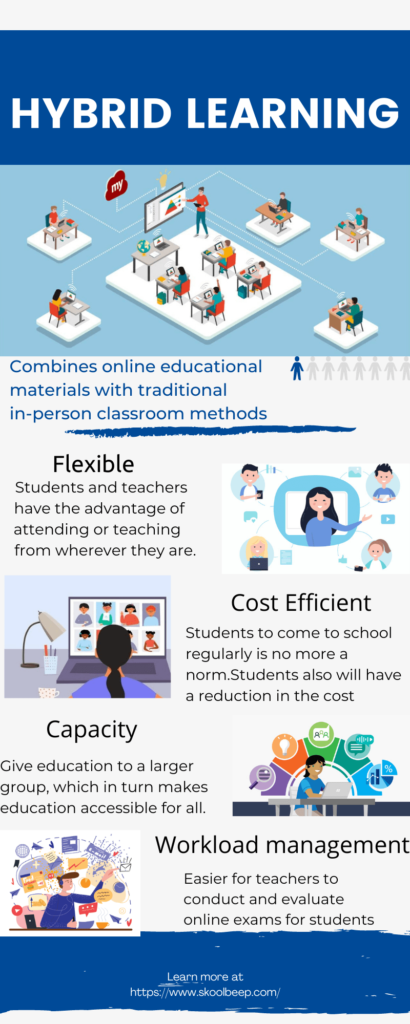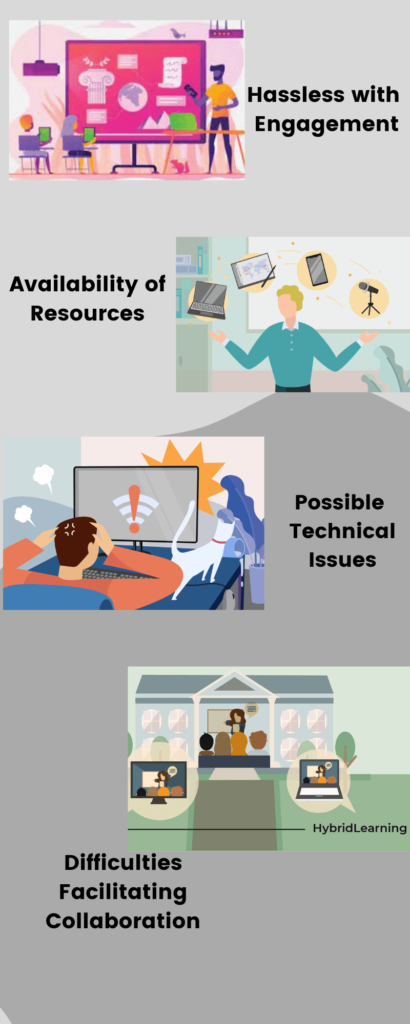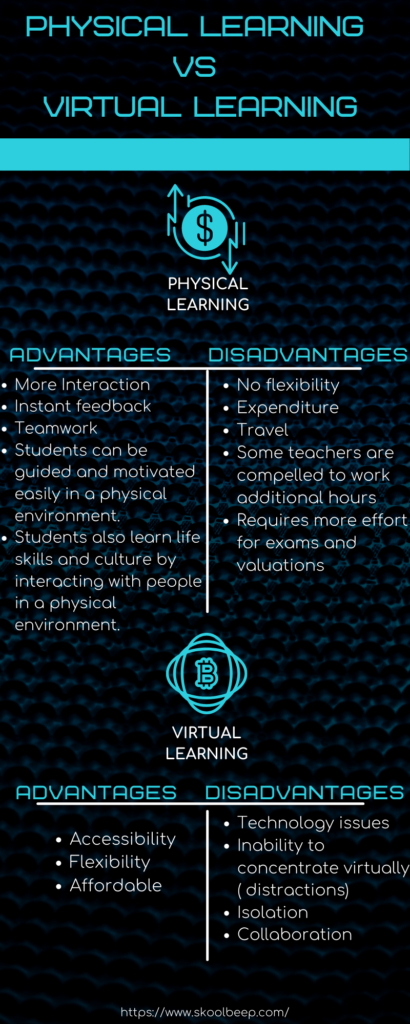Embracing the hybrid learning model for schools
What is a Hybrid Learning Model?
Hybrid learning is a term used to describe the learning model that combines different learning styles and approaches, mixing both digital and physical learning environments.
In simple words, it can be defined as the learning approach that merges online activities with classroom education.
With the hybrid learning model, teachers can take online and offline classes simultaneously, i.e. they can deliver live instructions to the students in the classroom (or in-person) and the remote students.
Hybrid Learning Vs Physical Learning:
In the physical classroom mode of learning, the teachers and students walk into a school building, sit down in a classroom and interact directly. This method has a lot of infrastructure requirements like classrooms, labs, furniture etc.
Whereas hybrid learning is a model which utilizes virtual learning and physical learning in the right balance, with very minimal infrastructure.
Major benefits of the Hybrid Learning Model:
Flexibility
In the current world pandemic scenario, it makes more sense to attend the classes remotely than attending a physical classroom. This flexibility, to an extent, helps to prevent covid 19 from spreading inside the school.
With the hybrid learning system, students and teachers have the advantage of attending classes or teaching online from anywhere at any time by utilizing a device with an internet connection.
Apart from the live online classes, students also can listen to/attend recorded sessions at their convenient time. Such options are much helpful for students, especially for those who work part-time to make a living.
Cost-efficient
With hybrid learning, the students are not required to come to school regularly. They mostly go to the school either once a week, twice a week or rather once a month. This means that the school/college needs to have fewer infrastructures, and their operational costs also get reduced.
Students also enjoy a reduction in the cost they need to spend on travel, tuition fees, and other normal expenditures.
Capacity
When it comes to hybrid learning, students’ capacity to attend a class is no more a concern since the learning environment is mostly virtual. This guarantees that the teachers can provide education to a larger group, making education accessible for all.
Workload management
Some of the lectures can be converted into recorded sessions, which considerably brings down the work effort needed from the teachers. And also, since the effort required for evaluation is less, it is much easier for teachers to conduct and evaluate online exams for their students.

Challenges in embracing the hybrid learning model
Hassles with Engagement
One of the toughest challenges in hybrid learning is student engagement. It can be hard to keep students engaged when they are used to being in the classroom. With hybrid learning, students have to stay disciplined and become self-paced learners.
For example, if a class is being taught using a hybrid learning model, the students have to learn how to continue learning independently. They have to learn how to manage their time to continue learning outside of the classroom.
It can also be challenging for them to learn how to work independently. So the teachers might have to spend extra time with students who are having difficulty with the hybrid learning model.
Availability of resources
Not everyone will have the money to afford a device and a high-speed internet connection, mandatory for hybrid learning.
Possible technical Issues
When organizations upgrade their training to a new format, they often face several challenges.
The three most common challenges in embracing hybrid learning are:
- » Technical issues (video/audio quality).
- » Compatibility of devices supporting online education.
- » Network connectivity.
Difficulties Facilitating Collaboration
Collaboration is a great way to work together. It is a big part of the daily lives of teachers and students. Achieving a goal by working together enhances the work experience and improves team working skills.
In normal classroom learning, students and teachers can easily collaborate with themselves. But in remote learning, it is not so easy for people at different locations to collaborate. For that, there should be a tool in the online learning management system that facilitates collaboration. Otherwise, they will be required to hire a third-party application to facilitate the collaboration.
Distributing Learning Materials
The learning materials are often created on an individual basis because students usually work individually. Each student has their schedule, their way of learning, and their preferred learning materials. This makes it very difficult to share files and learning materials with students. There is also a challenge of finding an apt way to share files and learning materials among students.

Advantages and Disadvantages of Physical learning:
Advantages:
» Interaction between the students and teachers
» Instant feedback
» Teamwork
» Students can be guided and motivated easily in a physical environment
» Students also develop life skills and culture by interacting with people in a physical environment
Disadvantages:
» No flexibility
» More expenditure
» Travel considerations
» Some teachers are compelled to work additional hours
» Requires more effort for exams and evaluations
Advantages and disadvantages of virtual learning
Advantages:
» Accessibility
» Flexibility
» Affordability
Disadvantages:
» Technology issues
» Inability to concentrate virtually ( distractions)
» Isolation
» Difficulty in collaboration

Why Hybrid Model?
The hybrid learning model is a method of learning that uses a combination of both classroom instruction and online classes to deliver training. Many people choose to take hybrid courses because they provide a more flexible schedule and cost savings than traditional classroom training. Courses in a hybrid learning model often use various media, including text, audio, and video, to communicate information to students. This makes the learning process more engaging and fun.
Some of the drawbacks of virtual learning can be eliminated in a hybrid model since students can still go to school at proper intervals. These regular meetings ensure increased collaboration and also support students who have difficulty learning in a virtual environment.
Best practices from some of the top universities
Most universities across the world have been following the hybrid learning model for some time now. With hybrid learning, you always have the opportunity to study in the top universities irrespective of your location.
Some of the best practices that the top universities follow are,
Design the course to meet learning outcomes rather than using specific technologies.
Understand student preferences and context while designing the course.
Promote collaborative learning
Future of technology in education
The recent past has seen a huge rise in the number of remote learning and virtual classroom models. Part of this is due to the outbreak of the coronavirus pandemic. Other prominent reasons include the education costs, rise in technology, and the need to cater to a wider audience. The hybrid learning models will play a major role in the future of education and will change the way we structure the education system.
The use of virtual and augmented reality tools for online learning is growing fast. Some of the top colleges worldwide have already started incorporating virtual reality and augmented reality as part of their hybrid learning curriculum.
Almost all major tech giants have come out with their versions of VR/AR devices. VR and AR are becoming more popular, and these kinds of technology advancements will make hybrid learning a much better experience for the students.
Education will become more inclusive, more accessible, more affordable, flexible, innovative, learner-centred, and lifelong. The traditional rigid system of education will evolve into a flexible hybrid model that will help to prepare the future workforce for the digital world
Conclusion
This blog post can help you to understand the advantages and disadvantages of hybrid learning.
As we all know, technology is transforming education at a rapid pace. When schools reopen, we predict that the hybrid learning model will be in full swing.

